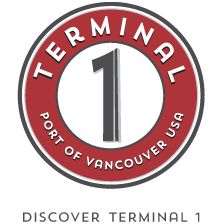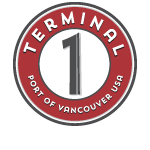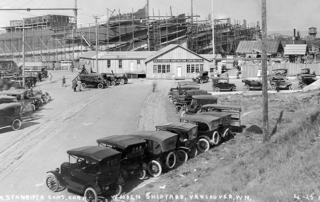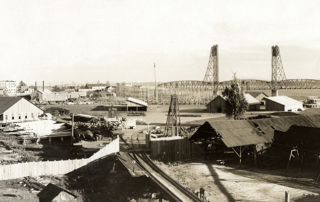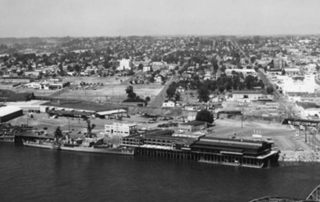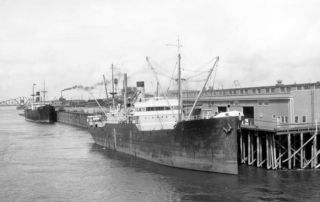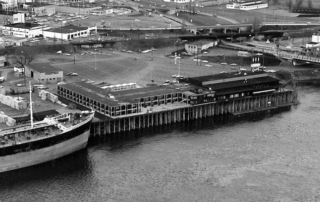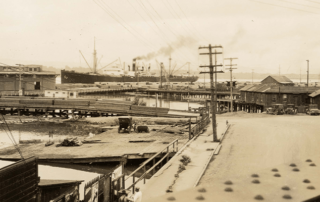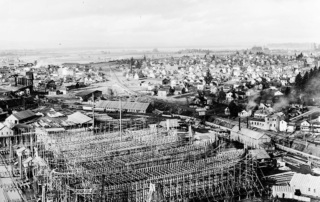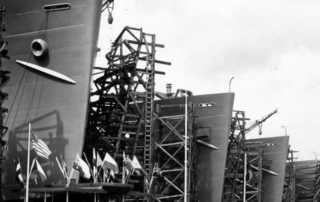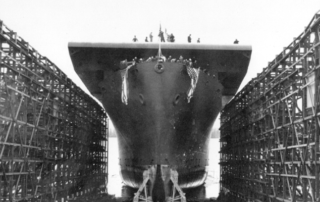Port of Vancouver
Historic Waterfront
As we look back to the early 20th Century, Terminal 1 at the Port of Vancouver played an important role in the economic growth of the city and the region.
Archeologists estimate Native American settlements existed along the lower and middle Columbia River as early as 10,000-15,000 years ago. Chinook people lived along the Columbia River in this area and utilized the river’s resources, which supported an abundance of salmon and other fish. The Columbia River allowed for efficient travel by canoe, facilitating a widespread trade network among both riverine and inland peoples, including Chinook, Cowlitz, Klikitat, Taidnapam, Shahala, Kalapuya, and Molala, who congregated in the area each spring.
Fort Vancouver was established in 1824 by the venerable fur-trading business, Hudson’s Bay Company (HBC). Access to the Columbia River was vital to the success of the company as English ships entered the river to supply the fort and ship out furs. Native Americans traded salmon, furs, and other goods from their canoes. As Americans arrived and settled due to the Donation Land Claim Act of 1850, the region overcame a British territorial claim to the Northwest and became a United States Territory. The city of Vancouver developed and incorporated in 1857.
Vancouver became a regular stop on an 1854 steamboat route, and by 1889 when Washington became a state, several lumber mills soon operated along the river. The Vancouver Klickitat & Yakima Railway provided rail access to the waterfront docks, and expectations for lumber exports ran high. Clark County also became the prune capital of the world as prune-packing plants sent fruit to the East Coast and Europe by rail and ship.
As the third-oldest Washington port, the terminal also became one of the largest in state. In 1912, voters established formal public ownership of the waterfront trade docks to protect public access to this vital economic engine so essential to community growth.
The Interstate Bridge was completed in 1917, replacing a ferry located at the foot of Washington Street. In 1918, the Port of Vancouver took over the adjacent site of the G. M. Standifer Construction Company, which had built ships for the World War I effort and whose large industrial development was instrumental to the port’s early success.
In 1921 a large municipal dock was built on the waterfront to increase export opportunities. It was expanded a year later, directly west of the bridge. Lumber was the first cargo shipped out from the dock, followed by loads of prunes and shingles.
Control of the municipal dock was transferred to the Port of Vancouver in 1926 and the Terminal No. 1 warehouse was built on an extension of the dock’s timber pier structure. All types of cargo, produce, and goods were shipped and received internationally from the new dock.
In the early 1930s, the prospect of exporting grain prompted improvements and expansion of the port’s terminal facilities, particularly within the western portion of the former shipyard. This included construction of the Pacific Continental Grain Company grain elevator facility and rail spurs off the Spokane Portland & Seattle Railway. Locally, the Columbia River was dredged to accommodate shipping traffic to the grain elevator and the dredge fill was deposited along the shoreline to fill tidal flats. In addition to the grain facility, dock space was constructed at Terminal No. 2 in 1936 to ease the bulging capacity at Terminal No. 1.
Many years later when the Interstate Bridge required expansion, the east portion of the Terminal No. 1 warehouse and dock was removed to make way for a second bridge span, completed in 1958. By 1959, the operations at Terminal No. 1 had been relegated to storage because of its reduced capacity, tight turning basin due to bridge encroachment, and the previous transfer of major shipping operations to Terminal No. 2.
As the Terminal No. 1 warehouse became less relevant, the Inn at the Quay was built in a portion of the property and opened in 1960 under a lease agreement with the port. The ship-themed restaurant and tiki bar expanded into a large hotel complex in the 1960s and early 1970s, later renamed the Red Lion Hotel Vancouver at the Quay. The venue was immensely popular with local residents, serving as the backdrop for generations of family functions and special events.
The business closed in 2015 and the 10-acre site is slated for redevelopment by the port as a revitalized public space. The Warehouse 23 restaurant operated in the Terminal No. 1 warehouse building during a portion of the redevelopment.





Once again, Terminal 1 is inspiring new commerce, bold ideas, and tantalizing delights to enliven each new day for Vancouver locals and visitors.
